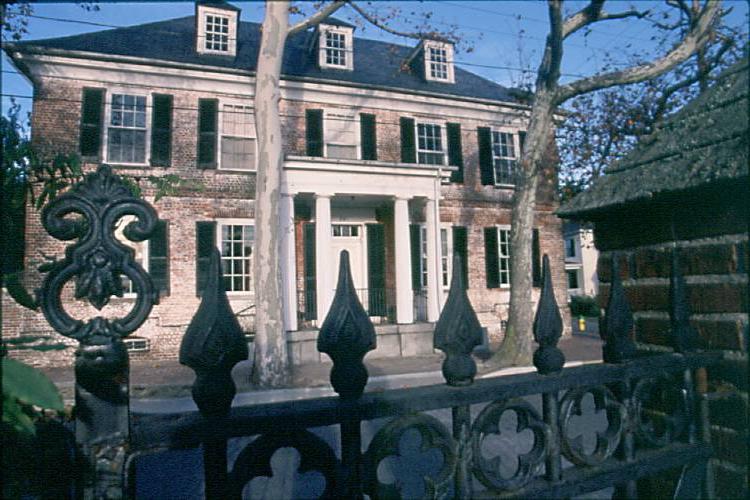

Hynson-Ringgold房子
The 18th-century Hynson-Ringgold房子 has served as the home of 九州娱乐官网’s 1950年以来的总统. It was also once home to generations of enslaved people. 这 account of its history is based on research conducted at the Starr Center in 2013 by Jamie Mansbridge, an international exchange student from Royal Holloway, University 伦敦的. Additional research was conducted in 2019 by students working on Chesapeake Heartland: An African American Humanities Project.
一个由奴隶服务的房子
The Hynson-Ringgold房子 was built in 1743 as a private residence (and office) for Dr. William Murray, a physician who purchased the land in 1735 from local landowner 纳撒尼尔Hynson. While the house changed ownership several times, records suggest 博士. Murray was the only owner of the house prior to the Civil War who was not 奴隶主. Between 1770 and 1863, approximately 25 enslaved people maintained 并为hyson - ringgold House提供服务.
In 1770, Thomas Ringgold V moved into the house after it was purchased by his father, Thomas Ringgold IV, a prominent merchant and slave trader who lived in the Custom 一个街区外的房子. Owner of a plantation on Quaker Neck, the younger Ringgold made several additions to the structure, including 仆人’ quarters adjoining the rear of the house, which would have housed some of the 17 enslaved people he owned. Ringgold的 will lists at least three enslaved people—a “cook,” “boy in the house,” and “housewench”—who likely lived and worked in the Hynson-Ringgold房子.
In the first two decades of the 1800s, the townhouse was again occupied by a plantation owner, Isaac Spencer, who ran a large farm outside of town. 记录显示斯宾塞的 household included four enslaved African Americans and one free African American.
Between 1835 and 1853, the house was owned by James E. 巴罗尔,一位杰出的律师 切斯特敦和九州娱乐官网的校友. 人口普查记录显示,巴罗尔 owned and lived with a number of enslaved people: in 1840, seven enslaved people ranging between 10 and 55 years of age were counted as occupants of the house, while in 1850, the house was served by three middle-aged men between 22 and 41 years of age and four 16到22岁的被奴役妇女.
自由的黑人社区
Throughout these same decades, Chestertown’s first enclave of free African Americans sprang to life on lower Cannon Street, adjacent to the Hynson-Ringgold房子. 亨利 Phillips, one of the earliest known Black landowners in Kent County, purchased a house at the corner of Queen and Cannon streets in 1796. 在19世纪20年代,托马斯·库夫买下了 很多没有. 5 just across the street from the Hynson-Ringgold房子, subdividing the land and selling it to other African Americans, including Isaac Boyer and Levi Rogers, who along with his wife, Eliza, opened the Cape May Saloon. 袖口的女儿,玛丽亚 Bracker, ran an ice cream shop out of her house at 104 Cannon Street. 1828年,袖口 and Boyer helped found Bethel AME church on the same block. 一些自由的非洲人 Americans who lived on Cannon Street would have worked inside of the Hyson-Ringgold 工资房. Others would have had relatives toiling inside the house as enslaved 仆人.
College Trustee Defends Slavery—and Rights of Free Blacks
In the years between 1853 and 1862, the Hynson-Ringgold房子 was owned and occupied 通过U.S. 参议员詹姆斯·阿尔弗雷德·皮尔斯. An early alumnus, longtime trustee, and part-time professor at 九州娱乐官网, Pearce vigorously defended the right to own slaves while striving to maintain the Union at the outbreak of the Civil War. 皮尔斯的关系 with slavery was a complicated one: while he admitted that slavery was an “evil” that must eventually be eradicated, he also held slaves and opposed what he saw as extremist abolitionism that he believed to be unconstitutional. 皮尔斯也担任国防 attorney for his African American neighbor, Levi Rogers, who was prosecuted in 1858-59 for illegally leaving Maryland and returning, thus violating state laws restricting 自由的非裔美国人的旅行. 与此同时,他试图为 rights of his Black neighbor, Pearce owned and lived with nine enslaved people, some of whom Levi Rogers must have known personally, including a 7-year-old girl, a 4-year-old 一个男孩和一个两岁的小孩.
Pearce also employed a free “House Servant” named Moses Berry at the Hynson-Ringgold House, who in February 1864 enlisted in Company A of the 32nd United States Colored 步兵. Berry would fight admirably in the Battle of Honey Hill and be promoted to the rank of Corporal before being discharged due to a lung condition caused from "在执行任务时暴露.” After his service, Berry returned to the Hynson-Ringgold House to work for Pearce’s family as a gardener, and later moved to Washington, D.C., 和他的妻子亨丽埃塔.
Hynson-Ringgold房子 Becomes Home of College Presidents
Through the efforts of Wilbur Ross Hubbard—entrepreneur, historic preservationist, and trustee of the College—the Hynson-Ringgold房子 was purchased in 1944, after years of physical deterioration, and gifted to 九州娱乐官网 to serve as the 总统官邸. Daniel Gibson, who served from 1950 to 1970, was the first college president to occupy the Hynson-Ringgold房子.
